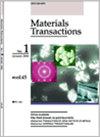Electrodeposition of Bi–Te Thermoelectric Material in Ethylene Glycol-BiCl<sub>3</sub>–TeCl<sub>4</sub> Non-Aqueous Solution
IF 1.9
4区 材料科学
Q4 MATERIALS SCIENCE, MULTIDISCIPLINARY
引用次数: 0
Abstract
The electrodeposition of bismuth–tellurium thermoelectric material was investigated by galvanostatic and potentiostatic electrolysis in ethylene glycol (EG)-BiCl3–TeCl4 non-aqueous solutions at 393 K. Controlling the molar ratio of BiCl3 to TeCl4 in the bath and the electrolysis conditions, the Bi–Te alloys with various compositions were electrodeposited. The composition of the electrodeposit obtained in the 97.50 mol%EG-2.45 mol%BiCl3–0.05 mol%TeCl4 bath with the BiCl3 to TeCl4 molar ratio of 50:1 at the current density of 20 A·m−2 was 40.14 mol%Bi–59.86 mol%Te and close to that of Bi2Te3. This electrodeposit exhibited a n-type thermoelectric conversion for the given temperature difference and its Seebeck coefficient was −145 µV K−1.Bi-Te热电材料在乙二醇中的电沉积- bicl <sub>3</sub> -TeCl<sub>4</sub>无水的解决方案
在393 K条件下,采用恒流电解和恒电位电解的方法研究了铋碲热电材料在乙二醇-BiCl3-TeCl4非水溶液中的电沉积。控制电解液中BiCl3与TeCl4的摩尔比和电解条件,电沉积了不同成分的Bi-Te合金。在电流密度为20 A·m−2、BiCl3与TeCl4摩尔比为50:1的97.50 mol%EG-2.45 mol%BiCl3 - 0.05 mol%TeCl4液中,得到的电镀层的组成为40.14 mol% Bi-59.86 mol%Te,与Bi2Te3相近。该镀层在给定温差下表现为n型热电转换,Seebeck系数为- 145µV K−1。
本文章由计算机程序翻译,如有差异,请以英文原文为准。
求助全文
约1分钟内获得全文
求助全文
来源期刊

Materials Transactions
工程技术-材料科学:综合
CiteScore
2.00
自引率
25.00%
发文量
205
审稿时长
2.7 months
期刊介绍:
Information not localized
 求助内容:
求助内容: 应助结果提醒方式:
应助结果提醒方式:


